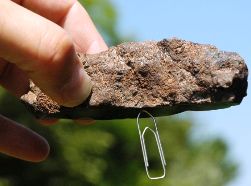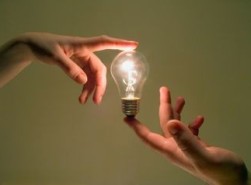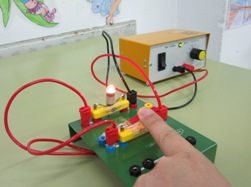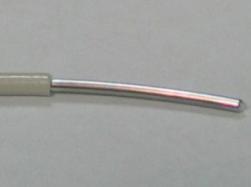The effect of LED lamps on human health
 The whole civilized world is gradually, but with more and more decisive, switching to LED lighting, and this is not at all surprising, since LEDs open a new era in the technology of light production itself, so this highly efficient technology claims to be the main one of its kind in 21 century. But how will the use of LEDs affect human health? We will try to figure it out now.
The whole civilized world is gradually, but with more and more decisive, switching to LED lighting, and this is not at all surprising, since LEDs open a new era in the technology of light production itself, so this highly efficient technology claims to be the main one of its kind in 21 century. But how will the use of LEDs affect human health? We will try to figure it out now.
Let's start with the environmental aspect associated with the content or absence of heavy metals in LED lamps. Most recently, fluorescent energy-saving lamps containing mercury vapor in a flask were very popular, and this is a fact that causes unreasonable fears. In the event of a malfunction, the disposal of such lamps should be done in a special way, they cannot simply be taken and thrown into the bin, and, as a result, in many countries these lamps are distributed ...
Magnetism - From Thales to Maxwell
 A thousand years before the first observations of electrical phenomena, mankind has already begun to accumulate knowledge about magnetism. And only four hundred years ago, when the formation of physics as a science had just begun, researchers separated the magnetic properties of substances from their electrical properties, and only after that they began to study them independently. This laid the experimental and theoretical foundation, which, by the middle of the 19th century, had become the foundation of a unified theory of electrical and magnetic phenomena.
A thousand years before the first observations of electrical phenomena, mankind has already begun to accumulate knowledge about magnetism. And only four hundred years ago, when the formation of physics as a science had just begun, researchers separated the magnetic properties of substances from their electrical properties, and only after that they began to study them independently. This laid the experimental and theoretical foundation, which, by the middle of the 19th century, had become the foundation of a unified theory of electrical and magnetic phenomena.
It seems that the unusual properties of magnetic iron ore were known as far back as the Bronze Age in Mesopotamia. And after the beginning of the development of iron metallurgy, people noticed that it attracts iron products. The ancient Greek philosopher and mathematician Thales from the city of Miletus (640−546 BC) also thought about the reasons for this attraction, he explained this attraction by the animation of the mineral. Greek thinkers presented themselves as invisible couples ...
 October 26, 1896, a 35-year-old native of the American city of Murray, Kentucky, self-taught experimenter, farmer Nathan Beverly Stubblefield applied for a new patent. This patent was supposed to be the third patent of the inventor after the two previous ones.
October 26, 1896, a 35-year-old native of the American city of Murray, Kentucky, self-taught experimenter, farmer Nathan Beverly Stubblefield applied for a new patent. This patent was supposed to be the third patent of the inventor after the two previous ones.
Previous patents were for a lighter for kerosene lamps and a mechanical telephone, which he received several years ago. In this case, the subject of patenting was a special electric battery, an earth battery. The inventor took a rather original approach to using a volt pair as the basis for creating a new class of current source.
As you know, a galvanic effect occurs when a galvanic pair is immersed in moist earth or water, which allows electricity to be supplied to an external circuit of very low power. Significant current could not be obtained from such a source ...
Wireless power transmission methods
 The law of the interaction of electric currents, discovered by Andre Marie Ampere in 1820, laid the foundation for the further development of the science of electricity and magnetism. After 11 years, Michael Faraday experimentally established that a changing magnetic field generated by an electric current is capable of inducing an electric current in another conductor. So the first electric transformer was created.
The law of the interaction of electric currents, discovered by Andre Marie Ampere in 1820, laid the foundation for the further development of the science of electricity and magnetism. After 11 years, Michael Faraday experimentally established that a changing magnetic field generated by an electric current is capable of inducing an electric current in another conductor. So the first electric transformer was created.
In 1864, James Clerk Maxwell finally systematized the experimental data of Faraday, giving them the form of exact mathematical equations, thanks to which the basis of classical electrodynamics was created, because these equations described the relationship of the electromagnetic field with electric currents and charges, and the consequence of this should be the existence of electromagnetic waves.In 1888, Heinrich Hertz experimentally confirmed the existence of electromagnetic waves...
Resonant method of wireless transmission of electric energy by Nikola Tesla
 At the beginning of the 20th century, scientist Nikola Tesla, a native of Croatia, then working in New York, developed an innovative method for transmitting electric energy over long distances without wires, using the phenomenon of electrical resonance, the study of which the scientist then paid special attention. Prior to this, he had already sufficiently studied the possibilities of alternating current, and clearly understood the technical prospects of its application, but there was another important step ahead - a system for wireless transmission of electrical energy.
At the beginning of the 20th century, scientist Nikola Tesla, a native of Croatia, then working in New York, developed an innovative method for transmitting electric energy over long distances without wires, using the phenomenon of electrical resonance, the study of which the scientist then paid special attention. Prior to this, he had already sufficiently studied the possibilities of alternating current, and clearly understood the technical prospects of its application, but there was another important step ahead - a system for wireless transmission of electrical energy.
According to the scientist, in such an electric power transmission system, planet Earth acted as an electric conductor, in which standing waves could be excited using electric oscillators (electric oscillatory systems). Tesla came to this conclusion through observations of electrical disturbances propagating over the earth's surface after lightning discharges during a thunderstorm ...
Where does the electricity flow?
 An electric current arises in an electric circuit including a current source and a consumer of electricity. But in what direction does this current occur? It is traditionally believed that in the external circuit the current has a direction from the plus of the source to minus, while inside the power source it is from minus to plus.
An electric current arises in an electric circuit including a current source and a consumer of electricity. But in what direction does this current occur? It is traditionally believed that in the external circuit the current has a direction from the plus of the source to minus, while inside the power source it is from minus to plus.
Indeed, electric current is the ordered movement of electrically charged particles. If the conductor is made of metal, these particles are electrons - negatively charged particles. However, in the external circuit, the electrons move precisely from the minus (negative pole) to the plus (positive pole), and not from plus to minus.
If you include a diode in the external circuit, it will become clear that current is possible only when the diode is connected by the cathode in the direction of the minus. From this it follows that the direction of the electric current in the circuit is taken ...
Peltier effect: the magic effect of electric current
 The beginning of the 19th century. The Golden Age of Physics and Electrical Engineering. In 1834, the French watchmaker Jean-Charles Peltier placed a drop of water between the bismuth and antimony electrodes, and then passed an electric current through the circuit. To his amazement, he saw that the drop had suddenly frozen.
The beginning of the 19th century. The Golden Age of Physics and Electrical Engineering. In 1834, the French watchmaker Jean-Charles Peltier placed a drop of water between the bismuth and antimony electrodes, and then passed an electric current through the circuit. To his amazement, he saw that the drop had suddenly frozen.
The thermal effect of electric current on the conductors was known, but the opposite effect was akin to magic. You can understand the feelings of Peltier: this phenomenon at the junction of two different areas of physics - thermodynamics and electricity, causes a feeling of miracle today.
The cooling problem was not as acute as it is today. Therefore, the Peltier effect was addressed only after almost two centuries, when electronic devices appeared, for the operation of which miniature cooling systems were required. The advantage of Peltier cooling elements is their small dimensions ...
Why can not connect copper and aluminum in the wiring?
 The fact that in electrical engineering it is impossible to directly connect copper and aluminum conductors is not a secret even for many ordinary people who have nothing to do with electrics. On the part of the same inhabitants, professional electricians often ask: “Why?”.
The fact that in electrical engineering it is impossible to directly connect copper and aluminum conductors is not a secret even for many ordinary people who have nothing to do with electrics. On the part of the same inhabitants, professional electricians often ask: “Why?”.
Pochemochki of any age can drive anyone into a dead end. Here is a similar case. A typical professional answer: “Why, why ... Because it will burn. Especially if the current is high. " But this does not always help. Since this is often followed by another question: “Why will it burn? Why does copper with steel not burn, aluminum with steel not burn, and aluminum with copper burn? ” To the last question you can hear different answers. Here are some of them. Aluminum and copper have different coefficients of thermal expansion.When current flows through them, they expand in different ways. ...
